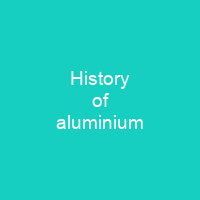Aluminium metal is very rare in native form, and the process to refine it from ores is complex. The compound alum has been known since the 5th century BCE and was used extensively by the ancients for dyeing. Soon after its discovery, the price of aluminium exceeded that of gold. It was only reduced after the initiation of the first industrial production by French chemist Henri Étienne Sainte-Claire Deville.
About History of aluminium in brief

The history of aluminium was shaped by the usage of its compound alum. The ancients used it as a dyeing mordant, in medicine, in chemical milling, and as a fire-resistant coating for wood to protect fortresses from enemy arson. In World Wars I and II, aluminium was a crucial strategic resource for aviation. The metal became an exchange commodity in the 1970s, and aluminium recycling gained ground. The first written record of alum was in the 5 fourth century BCE by Greek historian Herodotus. The Roman writer Petronius mentioned in his novel Satyricon that an unusual glass had been presented to the emperor: after it was thrown on the pavement, it did not break but only deformed. After learning from the inventor that nobody else knew how to produce this material, the emperor had the inventor executed so that it does not diminish the price. For this is not found among the Latins except a very small quantity. But I have found seven mountains so rich in this material that they could supply seven worlds. If you will give orders to engage workmen, build furnaces, and smelt the ore, you will provide all Europe with alum and the Turk will lose all his profits. Instead they will accrue to you…. The story was mentioned briefly in Natural History by Roman historian Pliny the Elder and Roman historian Cassius Dio. Some sources suggest this glass could be aluminium.
You want to know more about History of aluminium?
This page is based on the article History of aluminium published in Wikipedia (as of Dec. 03, 2020) and was automatically summarized using artificial intelligence.







